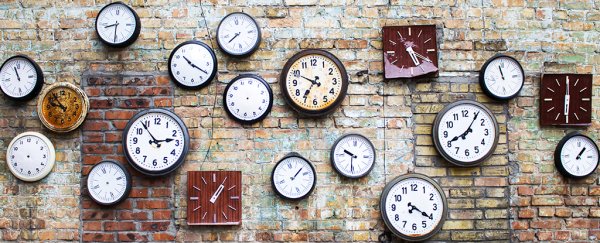Time is weird – in spite of what we think, the Universe doesn't have a master clock to run by, making it possible for us to experience time differently depending on how we're moving or how much gravity is pulling on us.
Now physicists have combined two grand theories of physics to conclude not only is time not universally consistent, any clock we use to measure it will blur the flow of time in its surrounding space.
Don't worry, that doesn't mean your wall clock is going to make you age quicker. We're talking about time keepers in highly precise experiments here, such as atomic clocks
A team of physicists from the University of Vienna and the Austrian Academy of Sciences have applied quantum mechanics and general relativity to argue that increasing the precision of measurements on clocks in the same space also increases their warping of time.
Let's take a step back for a moment and consider in simple terms what physicists already know.
Quantum mechanics is incredibly useful in describing the Universe on a very tiny scale, such as sub-atomic particles and forces over short distances.
As accurate and incredibly useful as the mathematics supporting quantum mechanics might be, it makes predictions which seem counter-intuitive to our everyday experiences.
One such prediction is called Heisenberg's uncertainty principle, which says as you know one thing with increasing precision, measurement of a complementary variable becomes less precise.
For example, the more you pinpoint the position of an object in time and space, the less certain you can be about its momentum.
This isn't a question of being clever enough or having better equipment – the Universe fundamentally works this way; electrons keep from crashing into protons thanks to a balance of 'uncertainty' of position and momentum.
Another way to think of it is this: objects with ultra-precise positions require us to consider increasingly ridiculous amounts of energy.
Applied to a hypothetical timepiece, splitting fractions of a second on our clock makes us less certain about the clock's energy.
This is where general relativity comes in – another highly trusted theory in physics, only this time it is most useful in explaining how massive objects affect one another at a distance.
Thanks to Einstein's work, we understand there is an equivalence between mass and energy, made famous in the equation (for objects at rest) as Energy = mass x speed of light squared (or E=mc^2).
We also know time and space are connected, and that this space-time can be affected as if it was more than just an empty box; mass – and therefore energy – can 'bend' it.
This is why we see cool things like gravitational lensing, where massive objects like stars and black holes dimple space so much, light can both travel straight and yet bend around them.
It also means mass can affect time through a phenomenon called gravitational time dilation, where time looks like it is running slower the closer it gets to a gravitational source.
Unfortunately, while the theories are both supported by experiments, they usually don't play well together, forcing physicists to consider a new theory that will allow them both to be correct at the same time.
Meanwhile, it's important that we continue to understand how both theories describe the same phenomena, such as time. Which is what this new paper does.
In this case, the physicists hypothesised the act of measuring time in greater detail requires the possibility of increasing amounts of energy, in turn making measurements in the immediate neighbourhood of any time-keeping devices less precise.
"Our findings suggest that we need to re-examine our ideas about the nature of time when both quantum mechanics and general relativity are taken into account", says researcher Esteban Castro.
So how does this affect us on a day-to-day level? Like a lot of theoretical physics, probably not much at all.
While quantum mechanics technically applies to 'big' things, don't worry, setting your stop-watch to read fractions of a second isn't going to open a worm-hole on your wrist – these findings would only become significant for clocks in highly precise experiments far more advanced than those currently being developed.
But getting a better understanding of how these time pieces work, in theory at least, will ultimately help us better understand the Universe around us. And one day perhaps grasp the nature of time itself.
This research was published in the Proceedings of the National Academy of Sciences.
